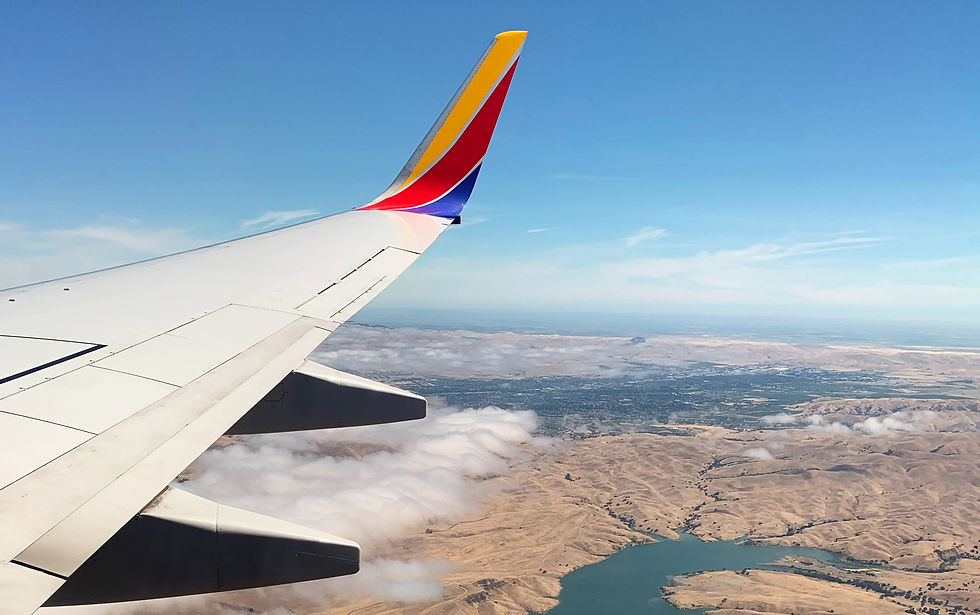BEHIND THE WING:
OVER THE GREAT PLAINS
It was March of 2013. I was on an airplane, seated just behind the wing, flying to the East Coast. Sitting in a window seat, 30,000 feet up in the air, thinking about why my husband and I were flying to BWI airport. We were contemplating moving back to Virginia, just two years after we had moved to Santa Fe, New Mexico.
I had retired from working in the advertising and graphic design world when we moved out West. My husband was offered a job as an air traffic controller at the airport in Santa Fe and he thought it would be a great place for me as well. He had traveled there years before, wandered up Canyon Road, and bought a painting at one of the galleries there.

What does the rest of your life look like when you gaze out the window of an airplane?
I was elated at finding myself in one of the biggest creative communities and art markets in the United States, where there are nearly 300 art galleries. So my husband's instincts were spot-on.
In the two years that we lived out West, I had worked hard at transitioning my thinking, from identifying myself as a commercial artist, towards feeling comfortable thinking of myself as a fine artist. It took time for me to make that shift in thinking. And then to get going and start producing some work.
So to be flying back East, pondering this decision to relocate back to Virginia, after just 24 months of living in Santa Fe, had me in the most contemplative frame of mind. All I could do was look out the window, observe the clouds come and go, and think about where fate and the universe were pointing us towards next.
There were times when I would look down to the ground, to observe the ever-changing countryside going by. First, was the view of the desert, with its earthy hues, then I saw green slowly emerging, then clusters of houses and roads and rivers meandering their way along the landscape.
We’d been in the air almost two hours when I looked out the window, once again, and discovered something truly extraordinary. It was the most geometric, graphic thing I had ever seen from a plane.

I was just 30,000 feet in the air, flying over the Great Plains. This NASA satellite image is from 1,635,000 feet.
I saw a virtual patchwork quilt of circles and squares and every shade of green there is. “What is all that?” I wondered. Thankfully, our pilot was kind enough to inform everyone on board that we were now flying over the Great Plains.
I was so inspired with what I was seeing, that I made a decision, then and there, to commemorate that moment with a piece of art one day.
Later, I started doing a little research and learned all about these eye catching circular shapes, interspersed amongst all the squares and rectangles of farmland below. They are called center pivot irrigation circles and they are formed thanks to a technological breakthrough in the agricultural industry in 1940. Most farmers back then irrigated their crops by using open ditches, which had to be dug with special equipment after planting, and had to be refilled before harvest. Think: linear irrigation.
But an industrious and ingenious farmer named Frank Zybach changed all that. He came up with a system of watering that entailed placing a pump in the center of a field, by a well, and with a really big sprinkler system that he invented (consisting of a large rig of irrigation pipes, supported by trusses, mounted on wheeled towers, that moved in a circular pattern), Frank could water over a hundred acres at a time, creating those distinctive, circular fields of crops when viewed from above. Now think: circular irrigation.
Center-pivot irrigation revolutionized the agricultural landscape in the Great Plains, once considered desert land. By the 1980s, irrigators sunk tens of thousands of wells, drawing on the massive Ogallala Aquifer.
Today, the Ogallala Aquifer, the underground reservoir that feeds this area with water, is disappearing. What’s particularly disconcerting is that this part of America supplies over one fifth of the annual agricultural harvest in the United States. If the aquifer goes dry, billions of dollars worth of food could disappear from our markets. And scientists say it would take 6,000 years to refill the reservoir through natural processes. Upon learning all this, that awestruck reaction I had, to my bird’s eye view of the Great Plains, took on a whole new perspective.

As I drove by those circular fields, I had a whole new outlook on what the future had in store for me.
About six months later, my husband and I moved to Virginia. We drove across the country and actually saw the center pivot irrigation systems in action, this time from a completely different vantage point on the ground.
Once I set up my new studio, the first piece of art I worked on was a painting of that time of transition, wondering what my life was going to look like. The painting is entitled: Behind the Wing: Over the Great Plains and it hangs in our kitchen.
Sources:
Smithsonian, Scientific American
